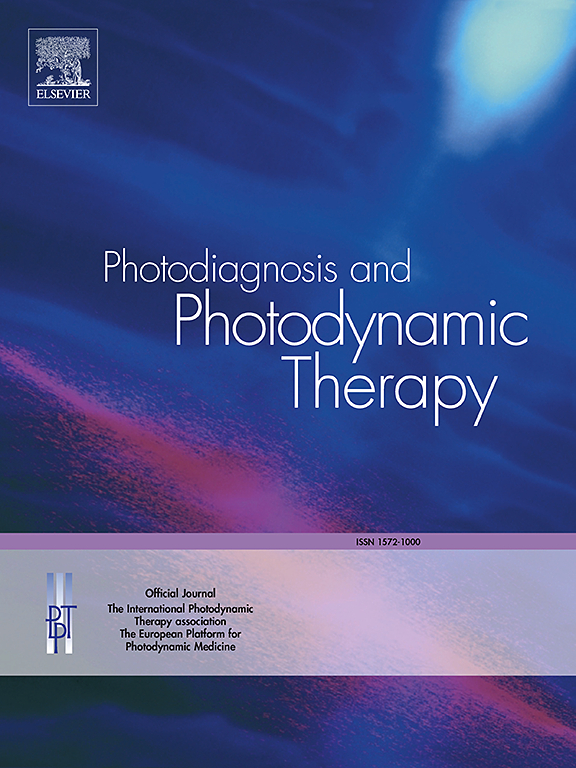研究不同空间后消毒剂Nd: YAP激光、Radachlorin和氧化钙纳米颗粒对PEEK桩与根管牙本质粘接耐久性和涂膜去除效果的影响。
IF 3.1
3区 医学
Q2 ONCOLOGY
引用次数: 0
摘要
目的:空间后消毒剂Nd: YAP激光、Radachlorin®光敏剂和氧化钙纳米颗粒(CaONPs)对聚醚醚酮(PEEK)桩与牙根的涂膜层(SL)去除效果和推出结合强度(PBS)的影响。方法:对44颗具有完整尖根的单根前磨牙进行牙髓治疗。盖茨滑动钻头被用来准备柱空间。按使用的消毒剂随机分为4组(n=11):第1组:2.5% NaOCl+17% EDTA,第2组:Nd: YAP激光+17% EDTA,第3组:Radachlorin+17% EDTA,第4组:CaONPs+17% EDTA。对每组的单个样本进行仔细切片,并在SEM放大下观察SL去除情况(n=1)。PEEK桩采用树脂水泥胶结,然后人工老化(n=10)。采用万能试验机进行PBS试验,在体视显微镜下分析失效模式。采用单向方差分析和事后分析对数据(p+ EDTA)样本进行统计评估,发现在去除SL和粘合完整性方面效果最差。结论:次氯酸钠加乙二胺-四乙酸处理后,PEEK桩与根管牙本质黏合时的SL去除效果和黏合完整性均优于其他各组。本文章由计算机程序翻译,如有差异,请以英文原文为准。
To investigate the impact of different post-space disinfectants Nd: YAP laser, Radachlorin, and calcium oxide nanoparticles on smear layer removal efficacy and bond durability of PEEK posts to canal dentin
Aims
Effect of post-space disinfectants Nd: YAP laser, Radachlorin® photosensitizer, and calcium oxide nanoparticles (CaONPs) on the smear layer (SL) removal efficacy and push out bond strength (PBS) of polyetheretherketone (PEEK) post to root dentin.
Methodology
Forty-four human premolars possessing a single root having a complete apex were acquired and endodontically treated. Gates glidden drills were used to prepare the post space. The teeth were then randomly allocated into 4 groups according to the disinfectant used (n = 11) Group 1: 2.5 % NaOCl+17 % EDTA, Group 2: Nd: YAP laser+17 % EDTA, Group 3: Radachlorin+17 % EDTA and Group 4: CaONPs+17 % EDTA. A single sample from each respective group was carefully sectioned and observed under SEM magnification for SL removal(n = 1). PEEK post was cemented using resin cement followed by artificial aging (n = 10). PBS testing was conducted using a universal testing machine and failure mode was analyzed under a stereomicroscope. A one-way analysis of variance, accompanied by post hoc analysis was applied for statistical assessment of data (p < 0.05)
Results
The specimens from Group 1 (2.5 % NaOCl+EDTA) (1.65±0.02) showed the highest efficacy in eliminating SL from the canal as well as the highest PBS. Conversely, Group 3 (Radachlorin+EDTA) samples revealed the least efficacy in the removal of SL and bond integrity of PEEK post.
Conclusion
Sodium hypochlorite followed by ethylenediamine-tetra acetic acid displayed better performance than all the other tested groups in SL removal and bond integrity outcomes when PEEK post was bonded to the canal dentin.
求助全文
通过发布文献求助,成功后即可免费获取论文全文。
去求助
来源期刊

Photodiagnosis and Photodynamic Therapy
ONCOLOGY-
CiteScore
5.80
自引率
24.20%
发文量
509
审稿时长
50 days
期刊介绍:
Photodiagnosis and Photodynamic Therapy is an international journal for the dissemination of scientific knowledge and clinical developments of Photodiagnosis and Photodynamic Therapy in all medical specialties. The journal publishes original articles, review articles, case presentations, "how-to-do-it" articles, Letters to the Editor, short communications and relevant images with short descriptions. All submitted material is subject to a strict peer-review process.
 求助内容:
求助内容: 应助结果提醒方式:
应助结果提醒方式:


